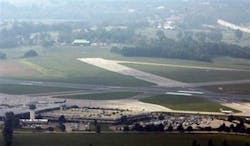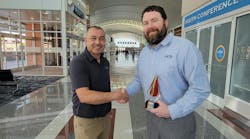Databases show hundreds of cases of pilots on wrong runways
The pilots of Comair Flight 5191, who tried to take off from the wrong runway in Lexington, Ky., early Sunday, were repeating a common error, according to government databases and aviation experts.
The CRJ-100 burst into flames and 49 of the 50 people aboard died after the jet sped off a short runway reserved for small private planes. Jets are supposed to use a nearby 7,003-foot runway that is twice the length of the smaller one.
Pilots report that in some cases it is easy to mistake one runway for another, especially at night or in poor weather. Aviation incident databases include hundreds of cases of pilots attempting to land or take off on the wrong runways.
Most often such mistakes are caught well before an accident occurs. In rare instances they have caused accidents. And the related risk of planes that stray into the paths of other planes on runways is considered one of the top aviation risks in the country.
"It's not the first time it's happened," said John Cox, a retired airline pilot who now works as a safety consultant.
On Oct. 31 in Taiwan, a Singapore Airlines jet tried to take off on a runway closed for construction. The jet broke apart after hitting construction equipment, killing 82 of the 179 people aboard.
The pilots of a small jet said that in November 1993 they nearly tried to take off on the same runway in Lexington where the accident occurred, according to a NASA report.
The pilots realized their mistake as an air traffic controller radioed a warning, the report said. The NASA Aviation Safety Reporting System does not identify the airline.
In many instances, jets traveling down the wrong runway are still able to take off.
"There are a lot (of planes) that actually do make wrong-runway takeoffs and just make it," says John Purvis, former chief accident investigator for Boeing.
"Black box" data
Investigators with the National Transportation Safety Board (NTSB) said Sunday evening that preliminary data from the jet's two "black box" recorders indicated that the pilots had attempted to take off from runway 26.
They had apparently been instructed by a controller to take off from runway 22, which is nearby. NTSB board member Debbie Hersman said the only instructions the pilots received were for the longer runway.
The route to the proper runway would have taken the pilots directly past the shorter strip. That runway, which the airport describes as narrow and "severely cracked," is 3,500 feet long. That is too short for a CRJ-100 to gather enough speed to lift off, according to Bombardier, the jet's manufacturer.
The jet knocked out an airport fence, skimmed over the adjacent rolling fields and broke apart. Jet fuel from the plane's wings touched off an intense blaze, which caused most of the fatalities, Fayette County Coroner Gary Ginn said.
NTSB investigators will take at least a year to determine what happened in the darkness at Blue Grass Airport. They will examine such issues as the amount of rest the pilots got the night before, the communication between the controller and the pilots, the runway markings and the airport lighting.
Recent problems with runway lights at the airport could have caused confusion. The smaller runway is not supposed to be lit at night, according to an airport guide. Normally, the longer runway's bright lights would make it easily distinguishable from the smaller runway.
However, most of the lights on the longer of the two runways had been inoperable until early Saturday and pilots had been notified of the outage, Federal Aviation Administration spokeswoman Laura Brown said. Brown declined to comment on the accident.
Capt. Terry McVenes, safety chief with the Air Line Pilots Association, said his union has long called for better signs and lights to help pilots avoid making wrong turns. "We think it's very important," said McVenes. "For $8 a gallon for paint, you can solve a lot of problems."
Similar incidents
A USA TODAY review of accidents and incidents in NTSB, FAA and NASA databases found hundreds of cases of pilots trying to take off or land on improper runways since the 1980s.
Among the examples:
*On Jan. 25, 2002, a China Airlines Airbus A340 took off from a taxiway in Anchorage. The pilots averted tragedy by lifting off nearly 1,000 feet sooner than normal. The jet's tires struck a snow bank at the end of the taxiway, but the plane was not damaged.
*On Nov. 22, 1994, two people in a small charter plane were killed when they struck a TWA Boeing MD-80 on a runway at Lambert-St. Louis International Airport. The NTSB found that the pilots of the small plane had attempted to take off on the wrong runway. The crash prompted changes in the way controllers and pilots communicate about runways.
*On Dec. 23, 1995, a Delta MD-80 took off from the wrong runway at Cleveland Hopkins Airport. "Investigation has revealed a number of wrong runway departures" in Cleveland, an FAA report said. Cleveland has since redesigned that area of the airport.
*In January and March 1989, two airline jets took off from the same closed runway at Houston's William P. Hobby Airport. In both cases the jets struck construction equipment but did not crash.






